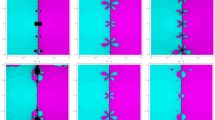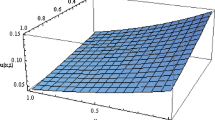Abstract
Explicit Runge-Kutta pairs are known to provide efficient solutions to initial value differential equations with inexpensive derivative evaluations. Two-step Runge-Kutta methods strive to improve the efficiency by utilizing approximations to the solution and its derivatives from the previous step. This article suggests a strategy for computing embeddedpairs of such two-step methods using a smaller number of function evaluations than that required for traditional Runge-Kutta methods of the same order. This leads to the efficient and reliable estimation of local discretization error and a robust step control strategy. The change of stepsize is achieved by a suitable interpolation of stage values from the previous step and does not require any additional function evaluations. Two examples illustrate the features of these pairs.
Similar content being viewed by others
References
P. Albrecht, A new theoretical approach to Runge-Kutta methods. SIAM J. Numer. Anal.,24 (1987), 391–406.
P. Albrecht, Consequences of a linear approach to Runge-Kutta methods. Manuscript.
P. Albrecht, The Runge-Kutta theory in a nutshell. SIAM J. Numer. Anal.,33 (1996), 1712–1735.
Z. Bartoszewski and Z. Jackiewicz, Construction of two-step Runge-Kutta methods of high order for ordinary differential equations. Numerical Algorithms,18 (1998), 51–70.
Z. Bartoszewski and Z. Jackiewicz, Toward a two-step Runge-Kutta code for nonstiff differential systems. To appear in Appl. Math.
J.C. Butcher, The Numerical Analysis of Ordinary Differential Equations. John Wiley, New York, 1987.
J.C. Butcher and S. Tracogna, Order conditions for two-step Runge-Kutta methods. Appl. Numer. Math.,24 (1997), 351–364.
G.D. Byrne and R.J. Lambert, Pseudo-Runge-Kuttamethods involvingtwo points. J. Assoc. Comput. Mach.,13 (1966), 114–123.
R. Caira, C. Costabile and F. Costabile, A class of pseudo Runge-Kutta methods. BIT,30 (1990), 642–649.
N. huu Cong and T. Mitsui, Collocation-based two-step Runge-Kutta methods. Japan J. Indust. Appl. Math.,13 (1996), 171–183.
E. Hairer, S.P. Nørsett and G. Wanner, Solving Ordinary Differential Equations I, Nonstiff Problems. Springer-Verlag, Berlin, Heidelberg, New York, 1991.
E. Hairer and G. Wanner, Order conditions for general two-step Runge-Kutta methods. SIAM J. Numer. Anal.,34 (1997), 2087–2089.
T.E. Hull, W.H. Enright, B.M. Fellen and A.E. Sedgwick, Comparing numerical methods for ordinary differential equations. SIAM J. Numer. Anal.,9 (1972), 603–637.
Z. Jackiewicz, R. Renaut and A. Feldstein, Two-step Runge-Kutta methods. SIAM J. Numer. Anal.,28 (1991), 1165–1182.
Z. Jackiewicz, R. Renaut and M. Zennaro, Explicit two-step Runge-Kutta methods. Appl. Math.,40 (1995), 433–456.
Z. Jackiewicz and R. Vermiglio, General linear methods with external stages of different orders. BIT,36 (1996), 688–712.
Z. Jackiewicz and S. Tracogna, A representation formula for two-step Runge-Kutta methods. Proc. of the Second Hellenic European Conference on Mathematics and Informatics (ed. E. Lipitakis), September 22–24, 1994, Hellenic Mathematical Society, Athens, Greece, 1994, 111–120.
Z. Jackiewicz and S. Tracogna, A general class of two-step Runge-Kutta methods for ordinary differential equations. SIAM J. Numer. Anal.,32 (1995), 1390–1427.
Z. Jackiewicz and S. Tracogna, Variable stepsize continuous two-step Runge-Kutta methods for ordinary differential equations. Numerical Algorithms,12 (1996), 347–368.
Z. Jackiewicz and M. Zennaro, Variable-stepsize explicit two-step Runge-Kutta methods. Math. Comp.,59 (1992), 421–438.
B. Owren and M. Zennaro, Derivation of efficient, continuous, explicit Runge-Kutta methods. SIAM J. Sci. Stat. Comput.,13 (1992), 1488–1501.
L.F. Shampine, Numerical Solution of Ordinary Differential Equations. Chapman & Hall, New York, London, 1994.
S. Tracogna, Implementation of two-step Runge-Kutta methods for ordinary differential equations. J. Comput. Appl. Math.,76 (1996), 113–136.
S. Tracogna and B. Welfert, Two-step Runge-Kutta methods. Theory and practice. BIT,40 (2000), 775–799.
J.H. Verner, Strategies for deriving new explicit Runge-Kutta pairs. Ann. Numer. Math.,1 (1994), 225–244.
J.H. Verner, High order explicit Runge-Kutta pairs with low stage order. Appl. Numer. Math.,20 (1996), 1–13.
Author information
Authors and Affiliations
Corresponding author
Additional information
The work of this author was supported by the National Science Foundation grant NSF DMS-9971164.
The work of this author was supported by the National Science and Engineering Council of Canada grant A8147.
About this article
Cite this article
Jackiewicz, Z., Verner, J.H. Derivation and implementation of Two-Step Runge-Kutta pairs. Japan J. Indust. Appl. Math. 19, 227–248 (2002). https://doi.org/10.1007/BF03167454
Received:
Revised:
Issue Date:
DOI: https://doi.org/10.1007/BF03167454




